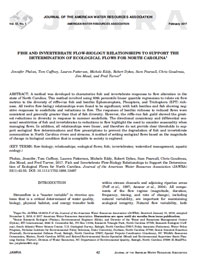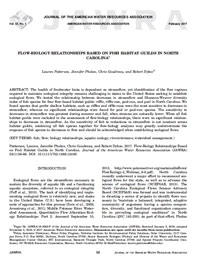Publications
Fish and Invertebrate Flow-Biology Relationships to Support the Determination of Ecological Flows for North Carolina
Following recent droughts in North Carolina, the General Assembly convened an Ecological Flows Science Advisory Board to develop a strategy for establishing flow regimes that could protect the ecological integrity in the streams and rivers of North Carolina. A new article in the Journal of the American Water Resources Association describes the method developed to characterize fish and invertebrate responses to flow alterations in the state of North Carolina to aid in setting ecologically sensitive flows that achieve appropriate environmental objectives.
Flow-Biology Relationships Based on Fish Habitat Guilds in North Carolina
The health of freshwater animal and plant life is dependent on streamflow, yet identification of the flow regimes required to maintain ecological integrity remains challenging to states in the U.S. seeking to establish ecological flows that achieve environmental objectives. A new article in the Journal of the American Water Resources Association tests the relationship between decreases in streamflow and Shannon-Weaver diversity index of fish species for four flow-based habitat guilds: riffle, riffle-run, pool-run, and pool in North Carolina. The study finds that species who prefer shallow habitats, such as riffles and riffle-runs were the most sensitive to decreases in streamflow, while using all fish data greatly underestimated the response of fish species to decreases in flow. Since ecological flows are designed to protect the integrity and diversity of aquatic ecosystems, ecological flows should be established to protect those species most sensitive to changes in flow.
Reservoir Sedimentation and Storage Capacity in the United States: Management Needs for the 21st Century
The United States federal government invested significant resources to build dams in the mid-twentieth century to increase water storage capacity nationwide; while only 5% of the dams in the United States are federally owned, they account for 61% of the total national storage capacity. Society is increasingly dependent on reservoir storage capacity due to increased water demand, increased population growth on floodplains protected by flood control dams, or increased demand on hydropower as a critical part of the electricity grid. Simultaneously, reservoir sedimentation diminishes storage capacity. Thus, there is a persistent chronic loss of the very resource upon which many aspects of modern society depend. Not measuring, assessing, and managing this resource undervalues it, and also perpetuates ignorance of threats to existing beneficiaries as well as obscuring opportunities for additional benefits. In order to most efficiently use the nation’s increasingly scarce reservoir storage capacity, the authors propose three modest actions for the hydraulic engineering community in the Journal of Hydraulic Engineering: expand nationwide reservoir sedementation surveys, supplement RESSED with initial planned sedimentation rates, and share responsibility for building reservoir sedimentation knowledge.
Paper: B. Everett Jordan Dam Sedimentation Rates and Reservoir Capacity
This paper provides a detailed report on major findings for B. Everett Jordan Dam within the context of all North Carolina reservoirs. While the majority of attention surrounds the ongoing assessment of water quality and nutrient management within Jordan Lake reservoir, our research on sedimentation rates can help uncover whether remaining sedimentation deposits pose an issue of capacity that should also be considered more actively as part of a broader water protection context.
Incorporating Blue Carbon as a Mitigation Action under the United Nations Framework Convention on Climate Change: Technical Issues to Address
Coastal and marine ecosystems store large amounts of carbon in soil sediments and vegetation. When these systems are disturbed through conversion or degradation, this emits carbon dioxide, a greenhouse gas whose growing atmospheric concentration is altering the climate system. Attention to this source of “blue carbon” emissions has only, fairly recently, been motivated by new scientific studies quantifying its magnitude. The United Nations Framework Convention on Climate Change (UNFCCC), as part of its mission to reduce threats to our global climate system, promotes the sustainable management, conservation, and enhancement of sinks and reservoirs of all greenhouse gases, including those in coastal marine ecosystems. Yet there are no specific mechanisms within the UNFCCC that focus on blue carbon. This paper reviews where coastal marine ecosystems and blue carbon may be addressed within existing UNFCCC mechanisms, such as those dealing with land use and reduced emissions from deforestation and degradation (REDD+), at the project and national levels.





